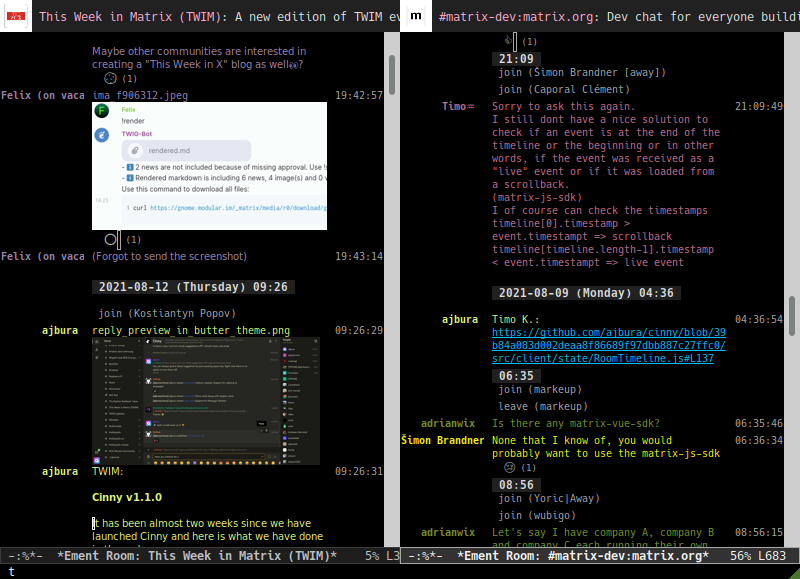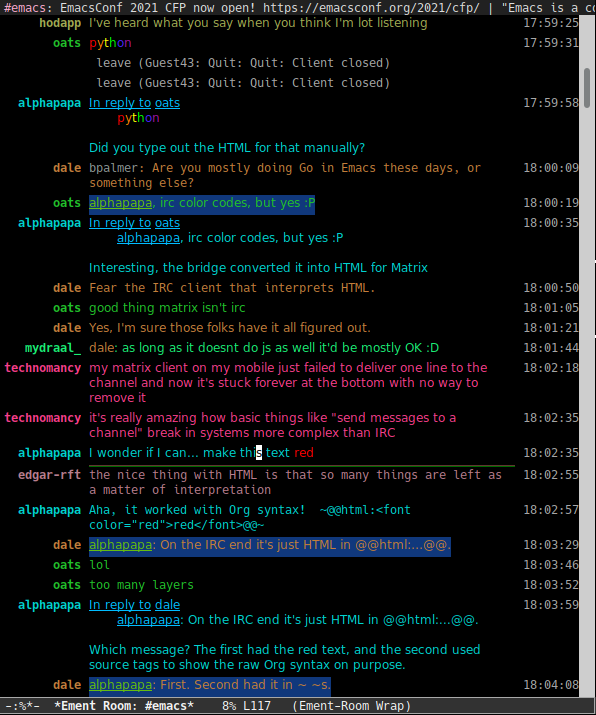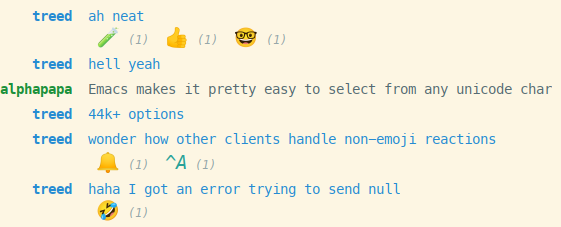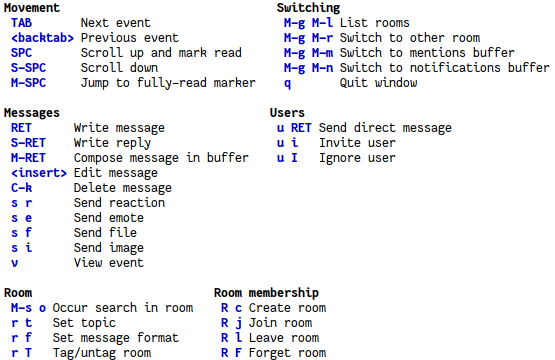Ement.el is a Matrix client for Emacs. It aims to be simple, fast, featureful, and reliable.
Feel free to join us in the chat room:
The default formatting style resembles IRC clients, with each message being prefixed by the username (which enables powerful Emacs features, like using Occur to show all messages from or mentioning a user). Alternative, built-in styles include an Element-like one with usernames above groups of messages, as well as a classic, no-margins IRC style. Messages may be optionally displayed with unique colors for each user (with customizeable contrast), making it easier to follow conversations. Timestamp headers are optionally displayed where a certain amount of time passes between events, as well as where the date changes.
Two rooms shown in side-by-side buffers, showing inline images, reactions, date/time headings, room avatars, and messages colored by user (using the modus-vivendi Emacs theme).
#emacs:libera.chat showing colored text from IRC users, replies with quoted parts, messages colored by user, addressed usernames colored by their user color, highlighted mentions, and the fully-read marker line (using the modus-vivendi Emacs theme).
Four rooms shown at once, with messages colored by user, in the default Emacs theme.
A room at the top in the “Elemental” display style, with sender names displayed over groups of messages, and only self-messages in an alternate color. The lower window shows an earlier version of the rooms list.
Reactions displayed as color emojis (may need proper Emacs configuration).
Ement.el is published in GNU ELPA, so it may be installed in Emacs with the command M-x package-install RET ement RET. This is the recommended way to install Ement.el, as it will install the current stable release.
Ement.el is also available in GNU Guix as emacs-ement.
Ement.el is also available in Debian as elpa-ement.
The master branch of the Git repository is intended to be usable at all times; only minor bugs are expected to be found in it before a new stable release is made. To install from this, it is recommended to use quelpa-use-package, like this:
;; Install and load `quelpa-use-package'.
(package-install 'quelpa-use-package)
(require 'quelpa-use-package)
;; Install Ement.
(use-package ement
:quelpa (ement :fetcher github :repo "alphapapa/ement.el"))One might also use systems like Straight (which is also used by DOOM) to install from Git, but the author cannot offer support for them.
Ement.el is intended to be installed with Emacs’s package system, which will ensure that the required autoloads are generated, etc. If you choose to install it manually, you’re on your own.
- Call command
ement-connectto connect. Multiple sessions are supported, so you may call the command again to connect to another account. - Wait for initial sync to complete (which can take a few moments–initial sync JSON requests can be large).
- Use these commands:
ement-list-roomsto view the list of joined rooms.ement-view-roomto view a room’s buffer, selected with completion.ement-create-roomto create a new room.ement-invite-userto invite a user to a room.ement-join-roomto join a room.ement-leave-roomto leave a room.ement-forget-roomto forget a room.ement-tag-roomto add (or with interactive prefix, remove) a tag on a room (including favorite/low-priority status).ement-list-membersto list members in a room.ement-send-direct-messageto send a direct message to a user (in an existing direct room, or creating a new one automatically).ement-room-edit-messageto edit a message at point.ement-room-send-fileto send a file.ement-room-send-imageto send an image.ement-room-set-topicto set a room’s topic.ement-room-occurto search in a room’s known events.ement-ignore-userto ignore a user (or with interactive prefix, un-ignore).ement-room-set-message-formatto set a room’s message format buffer-locally.ement-directoryto view a room directory.ement-directory-searchto search a room directory.
- Use these special buffers to see events from multiple rooms (you can also reply to messages from these buffers!):
- See all new events that mention you in the
*Ement Mentions*buffer. - See all new events in rooms that have open buffers in the
*Ement Notifications*buffer.
- See all new events that mention you in the
These bindings are common to all of the following buffer types:
- Switch to a room buffer:
M-g M-r - Switch to the room list buffer:
M-g M-l - Switch to the mentions buffer:
M-g M-m - Switch to the notifications buffer:
M-g M-n
- Show command menu:
?
Movement
- Next event:
TAB - Previous event:
<backtab> - Scroll up and mark read:
SPC - Scroll down:
S-SPC - Jump to fully-read marker:
M-SPC - Load older messages: at top of buffer, scroll contents up (i.e.
S-SPC,M-vormwheel-scroll)
Switching
- List rooms:
M-g M-l - Switch to other room:
M-g M-r - Switch to mentions buffer:
M-g M-m - Switch to notifications buffer:
M-g M-n - Quit window:
q
Messages
- Write message:
RET - Write reply to event at point (when region is active, only quote marked text) :
S-RET - Compose message in buffer:
M-RET(while writing in minibuffer:C-c ')(Use commandement-room-compose-orgto activate Org mode in the compose buffer.) - Edit message:
<insert> - Delete message:
C-k - Send reaction to event at point, or send same reaction at point:
s r - Send emote:
s e - Send file:
s f - Send image:
s i - View event source:
v - Complete members and rooms at point:
C-M-i(standardcompletion-at-pointcommand).
Images
- Toggle scale of image (between fit-to-window and thumbnail):
mouse-1 - Show image in new buffer at full size:
double-mouse-1
Users
- Send direct message:
u RET - Invite user:
u i - Ignore user:
u I
Room
- Occur search in room:
M-s o - List members:
r m - Set topic:
r t - Set message format:
r f - Set notification rules:
r n - Tag/untag room:
r T
Room membership
- Create room:
R c - Join room:
R j - Leave room:
R l - Forget room:
R F
Other
- Sync new messages (not necessary if auto sync is enabled; with prefix to force new sync):
g
- Show buffer of room at point:
RET - Show buffer of next unread room:
SPC - Move between room names:
TAB/<backtab>
- View/join a room:
RET/mouse-1 - Load next batch of rooms:
+
- Move between events:
TAB/<backtab> - Go to event at point in its room buffer:
RET - Write reply to event at point (shows the event in its room while writing) :
S-RET
- Desktop notifications are enabled by default for events that mention the local user. They can also be shown for all events in rooms with open buffers.
- Send messages in Org mode format by customizing the option
ement-room-send-message-filter(which enables Org format by default), or by callingement-room-compose-orgin a compose buffer (which enables it for a single message). Then Org-formatted messages are automatically converted and sent as HTML-formatted messages (with the Org syntax as the plain-text fallback). You can send syntax such as:- Bold, italic, underline, strikethrough
- Links
- Tables
- Source blocks (including results with
:exports both) - Footnotes (okay, that might be pushing it, but you can!)
- And, generally, anything that Org can export to HTML
- Starting in the room list buffer, by pressing
SPCrepeatedly, you can cycle through and read all rooms with unread buffers. (If a room doesn’t have a buffer, it will not be included.) - Room buffers and the room-list buffer can be bookmarked in Emacs, i.e. using
C-x r m. This is especially useful with Burly: you can arrange an Emacs frame with several room buffers displayed at once, useburly-bookmark-windowsto bookmark the layout, and then you can restore that layout and all of the room buffers by opening the bookmark, rather than having to manually arrange them every time you start Emacs or change the window configuration. - Images and other files can be uploaded to rooms using drag-and-drop.
- You can customize settings in the
ementgroup.- Note:
setqshould not be used for certain options, because it will not call the associated setter function. Users who have an aversion to the customization system may experience problems.
- Note:
Emacs may not display certain symbols and emojis well by default. Based on this question and answer, you may find that the simplest way to fix this is to install an appropriate font, like Noto Emoji, and then use this Elisp code:
(setf use-default-font-for-symbols nil)
(set-fontset-font t 'unicode "Noto Emoji" nil 'append)Ement.el doesn’t support encrypted rooms natively, but it can be used transparently with the E2EE-aware reverse proxy daemon Pantalaimon. After configuring it according to its documentation, call ement-connect with the appropriate hostname and port, like:
(ement-connect :uri-prefix "http://localhost:8009")Why write a new Emacs Matrix client when there is already matrix-client.el, by the same author, no less? A few reasons:
matrix-clientuses an older version of the Matrix spec, r0.3.0, with a few elements of r0.4.0 grafted in. Bringing it up to date with the current version of the spec, r0.6.1, would be more work than to begin with the current version. Ement.el targets r0.6.1 from the beginning.matrix-clientdoes not use Matrix’s lazy-loading feature (which was added to the specification later), so initial sync requests can take a long time for the server to process and can be large (sometimes tens of megabytes of JSON for the client to process!). Ement.el uses lazy-loading, which significantly improves performance.matrix-clientautomatically makes buffers for every room a user has joined, even if the user doesn’t currently want to watch a room. Ement.el opens room buffers on-demand, improving performance by not having to insert events into buffers for rooms the user isn’t watching.matrix-clientwas developed without the intention of publishing it to, e.g. MELPA or ELPA. It has several dependencies, and its code does not always install or compile cleanly due to macro-expansion issues (apparently depending on the user’s Emacs config). Ement.el is designed to have minimal dependencies outside of Emacs (currently only one,plz, which could be imported into the project), and every file is linted and compiles cleanly using makem.sh.matrix-clientuses EIEIO, probably unnecessarily, since few, if any, of the benefits of EIEIO are realized in it. Ement.el uses structs instead.matrix-clientuses bespoke code for inserting messages into buffers, which works pretty well, but has a few minor bugs which are difficult to track down. Ement.el uses Emacs’s built-in (and perhaps little-known)ewoclibrary, which makes it much simpler and more reliable to insert and update messages in buffers, and enables the development of advanced UI features more easily.matrix-clientwas, to a certain extent, designed to imitate other messaging apps. The result is, at least when used with thematrix-client-framecommand, fairly pleasing to use, but isn’t especially “Emacsy.” Ement.el is intended to better fit into Emacs’s paradigms.matrix-client’s long name makes for long symbol names, which makes for tedious, verbose code.ementis easy to type and makes for concise, readable code.- The author has learned much since writing
matrix-clientand hopes to write simpler, more readable, more maintainable code in Ement.el. It’s hoped that this will enable others to contribute more easily.
Note that, while matrix-client remains usable, and probably will for some time to come, Ement.el has now surpassed it in every way. The only reason to choose matrix-client instead is if one is using an older version of Emacs that isn’t supported by Ement.el.
Additions
- Present “joined-and-left” and “rejoined-and-left” membership event pairs as such.
Changes
- When selecting a room to view with completion, don’t offer spaces.
Fixes
- Use of send-message filter when replying.
Fixes
- Don’t show “curl process interrupted” message when updating a read marker’s position again.
Additions
- Option
ement-room-unread-only-counts-notifications, now enabled by default, causes rooms’ unread status to be determined only by their notification counts (which are set by the server and depend on rooms’ notification settings). - Command
ement-room-set-notification-statesets a room’s notification state (imitating Element’s user-friendly presets). - Room buffers’ Transient menus show the room’s notification state (imitating Element’s user-friendly presets).
- Command
ement-set-display-namesets the user’s global displayname. - Command
ement-room-set-display-namesets the user’s displayname in a room (which is also now displayed in the room’s Transient menu). - Column
Notificationsin theement-taxy-room-listbuffer shows rooms’ notification state. - Option
ement-interrupted-sync-hookallows customization of how sync interruptions are handled. (Now, by default, a warning is displayed instead of merely a message.)
Changes
- When a room’s read receipt is updated, the room’s buffer is also marked as unmodified. (In concert with the new option, this makes rooms’ unread status more intuitive.)
Fixes
- Binding of command
ement-forget-roomin room buffers. - Highlighting of
@roommentions.
Fixes
- Room unread status (when the last event in a room is sent by the local user, the room is considered read).
Additions
- Command
ement-directoryshows a server’s room directory. - Command
ement-directory-searchsearches a server’s room directory. - Command
ement-directory-nextfetches the next batch of rooms in a directory. - Command
ement-leave-roomaccepts aFORCE-Pargument (interactively, with prefix) to leave a room without prompting. - Command
ement-forget-roomaccepts aFORCE-Pargument (interactively, with prefix) to also leave the room, and to forget it without prompting. - Option
ement-notify-mark-frame-urgent-predicatesmarks the frame as urgent when (by default) a message mentions the local user or “@room” and the message’s room has an open buffer.
Changes
- Minor improvements to date/time headers.
Fixes
- Command
ement-describe-roomfor rooms without topics. - Improve insertion of old messages around existing timestamp headers.
- Reduce D-Bus notification system check timeout to 2 seconds (from the default of 25).
- Compatibility with Emacs 27.
Fixes
- Info manual export filename.
Changes
- Read receipts are re-enabled. (They’re now implemented with a global idle timer rather than
window-scroll-functions, which sometimes caused a strange race condition that could cause Emacs to become unresponsive or crash.) - When determining whether a room is considered unread, non-message events like membership changes, reactions, etc. are ignored. This fixes a bug that caused certain rooms that had no message events (like some bridged rooms) to appear as unread when they shouldn’t have. But it’s unclear whether this is always preferable (e.g. one might want a member leaving a room to cause it to be marked unread), so this is classified as a change rather than simply a fix, and more improvements may be made to this in the future. (Fixes #97. Thanks to Julien Roy for reporting and testing.)
- The
ement-taxy-room-listview no longer automatically refreshes the list if the region is active in the buffer. (This allows the user to operate on multiple rooms without the contents of the buffer changing before completing the process.)
Fixes
- Links to only rooms (as opposed to links to events in rooms) may be activated to join them.
- Read receipts mark the last completely visible event (rather than one that’s only partially displayed).
- Prevent error when a room avatar image fails to load.
Fixed
- Info manual directory headers.
Fixed
- Temporarily disable sending of read receipts due to an unusual bug that could cause Emacs to become unresponsive. (The feature will be re-enabled in a future release.)
Fixed
- Function
ement-room-synccorrectly updates room-list buffers. (Thanks to Visuwesh.) - Only send D-Bus notifications when supported. (Fixes #83. Thanks to Tassilo Horn.)
Fixed
- Function
ement-room-scroll-up-mark-readselects the correct room window. - Option
ement-room-list-avatarsdefaults to what functiondisplay-images-preturns.
After almost two years of development, the first tagged release. Submitted to GNU ELPA.
Bug reports, feature requests, suggestions — oh my!
Ement.el is published in GNU ELPA and is considered part of GNU Emacs. Therefore, cumulative contributions of more than 15 lines of code require that the author assign copyright of such contributions to the FSF. Authors who are interested in doing so may contact assign@gnu.org to request the appropriate form.
An Org-formatted version of the Matrix spec is available in the meta/spec branch.
GPLv3







